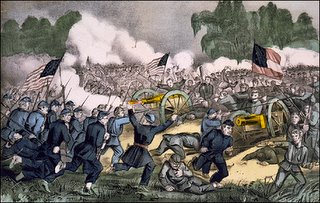
The battle of Gettysburg was one of the costliest battles of the Civil War, over 50,000 causalities. Every year, just in time for the anniversary of the battles of Gettysburg thousands of vultures arrive, just as they came to feast on the dead soldiers over a hundred years ago. Check this out…
On July 1, 1863 J.E.B. Stuart, famed confederate cavalry commander, rode through Carlisle en route to Gettysburg. Days later a stream of wounded Union and confederate soldiers poured into the makeshift hospital set up on the battlefields and in the camps. Enormous piles of amputated limbs sat outside hospitals like ‘Old West’, a testament to the grizzly realities and conditions of mid-nineteenth century hospitals and their inability to cope with modern warfare. Thousands of men, however, never made it to hospitals - or for that matter thousands never managed to leave the battlefield, they died where they had fought. The Plum Run, a stream passing through what is now a national military park, ran red with blood for days. Those left behind dead and dying littered the fields, reports from both sides confirmed that, “thousands of corpses bloated in the hot sun, severed limbs were strewn across the landscape, and flies and maggots and rats and vermin accumulated on the bodies everywhere.”
The high availability of carrion on the Gettysburg battlefield attracted vultures by the thousands. Gettysburg was inundated with both American Black and Turkey Vultures. It was a feast for the carrion birds. At first the vultures, the symbolic sentinels of death enjoyed a smorgasbord of human remains.
Burial details were quickly dispatched but even after they finished their work, the vultures remained to scavenge among the remains of the hundreds of horses left dead and bloated out on the open fields.
Today, thousands of vultures annually descend on Gettysburg, as they have for the past century, right around the anniversary of the battle. It seems that the vultures had been so enraptured with the feast provided for them that they were carried off their normal migratory routes, and as a result their migratory destination had been set to Gettysburg in early July. Virginia Polytechnic and Penn State University students working at the site explain that, “The birds seem to roost on Little Round Top and Big Round Top, two hills where some of the heaviest fighting of the entire Civil War took place.”
It is known that the vultures have been in that area of Pennsylvania for many hundreds of years, what is interesting is that they now choose to roost at the sight of the famous and deadly three day battle. Is each generation of vulture somehow telling the next generation about the great feast of their forebirds? Or is it more likely that the birds now return to the spot at the anniversary of the battle out of habit? Who knows, but it sure is a weird site to see!
I’m Average Joe
Battle of Gettysburg
Date: July 1-3, 1863
Location: Pennsylvania
Confederate Commander: Robert E. Lee
Union Commander: George G. Meade
Confederate Forces Engaged: 75,000
Union Forces Engaged: 82,289
Winner: Union
Casualties: 51,112 (23,049 Union and 28,063 Confederate but all American!!!!!)





3 comments:
I would love to have read all of this, but the cyan and yellow on white was too hard to see. Vultures coming back to Gettysburg was interesting though.
I would love to have read all of this, but the cyan and yellow on white was too hard to see. Vultures coming back to Gettysburg was interesting though.
I had same issue, but try clicking Ctrl+a to highlight the whole page and then you can read the blog.
Post a Comment